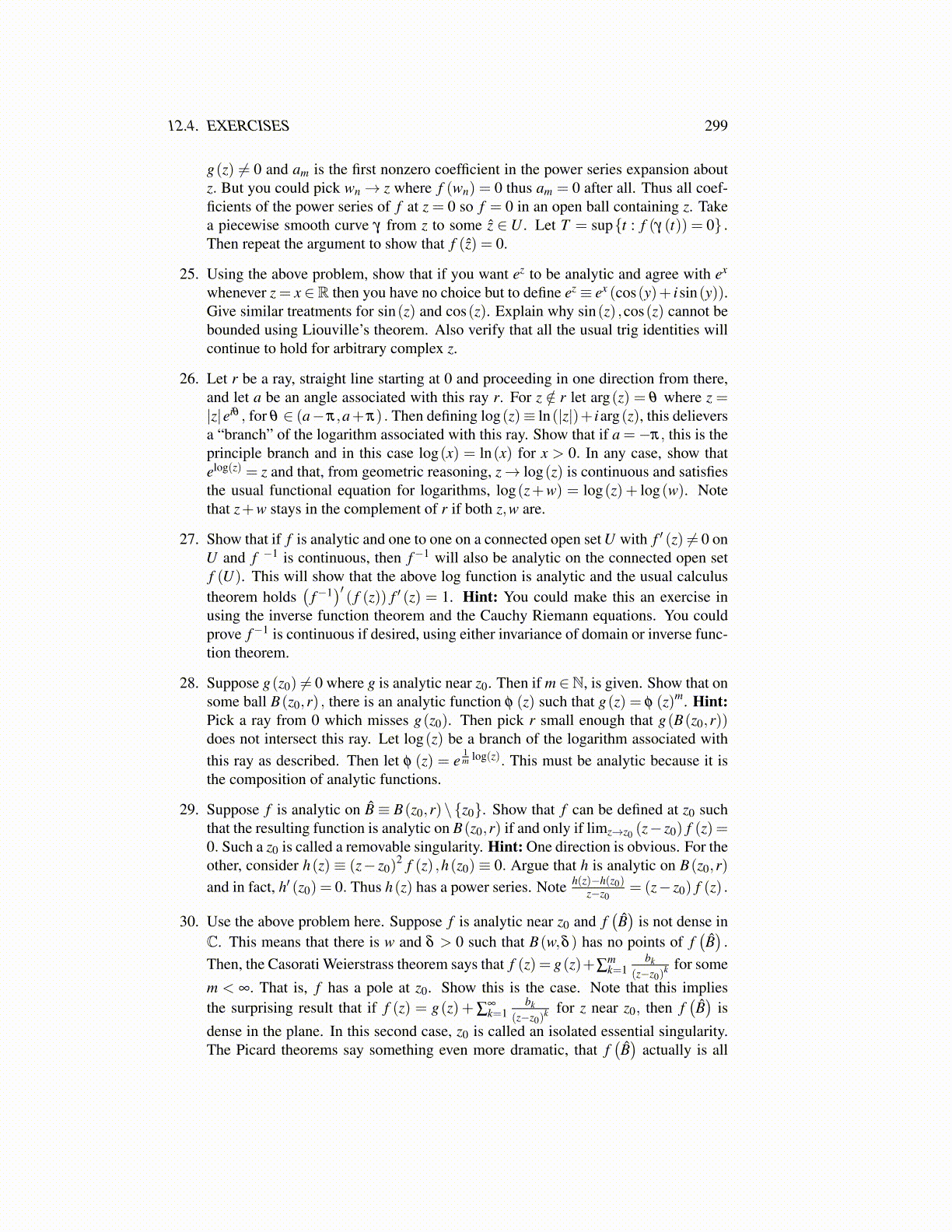
12.4. EXERCISES 299
g(z) ̸= 0 and am is the first nonzero coefficient in the power series expansion aboutz. But you could pick wn→ z where f (wn) = 0 thus am = 0 after all. Thus all coef-ficients of the power series of f at z = 0 so f = 0 in an open ball containing z. Takea piecewise smooth curve γ from z to some ẑ ∈U . Let T = sup{t : f (γ (t)) = 0} .Then repeat the argument to show that f (ẑ) = 0.
25. Using the above problem, show that if you want ez to be analytic and agree with ex
whenever z = x ∈R then you have no choice but to define ez ≡ ex (cos(y)+ isin(y)).Give similar treatments for sin(z) and cos(z). Explain why sin(z) ,cos(z) cannot bebounded using Liouville’s theorem. Also verify that all the usual trig identities willcontinue to hold for arbitrary complex z.
26. Let r be a ray, straight line starting at 0 and proceeding in one direction from there,and let a be an angle associated with this ray r. For z /∈ r let arg(z) = θ where z =|z|eiθ , for θ ∈ (a−π,a+π) . Then defining log(z)≡ ln(|z|)+ iarg(z), this delieversa “branch” of the logarithm associated with this ray. Show that if a =−π, this is theprinciple branch and in this case log(x) = ln(x) for x > 0. In any case, show thatelog(z) = z and that, from geometric reasoning, z→ log(z) is continuous and satisfiesthe usual functional equation for logarithms, log(z+w) = log(z) + log(w). Notethat z+w stays in the complement of r if both z,w are.
27. Show that if f is analytic and one to one on a connected open set U with f ′ (z) ̸= 0 onU and f −1 is continuous, then f−1 will also be analytic on the connected open setf (U). This will show that the above log function is analytic and the usual calculustheorem holds
(f−1)′( f (z)) f ′ (z) = 1. Hint: You could make this an exercise in
using the inverse function theorem and the Cauchy Riemann equations. You couldprove f−1 is continuous if desired, using either invariance of domain or inverse func-tion theorem.
28. Suppose g(z0) ̸= 0 where g is analytic near z0. Then if m∈N, is given. Show that onsome ball B(z0,r) , there is an analytic function φ (z) such that g(z) = φ (z)m. Hint:Pick a ray from 0 which misses g(z0). Then pick r small enough that g(B(z0,r))does not intersect this ray. Let log(z) be a branch of the logarithm associated withthis ray as described. Then let φ (z) = e
1m log(z). This must be analytic because it is
the composition of analytic functions.
29. Suppose f is analytic on B̂ ≡ B(z0,r)\{z0}. Show that f can be defined at z0 suchthat the resulting function is analytic on B(z0,r) if and only if limz→z0 (z− z0) f (z) =0. Such a z0 is called a removable singularity. Hint: One direction is obvious. For theother, consider h(z)≡ (z− z0)
2 f (z) ,h(z0)≡ 0. Argue that h is analytic on B(z0,r)and in fact, h′ (z0) = 0. Thus h(z) has a power series. Note h(z)−h(z0)
z−z0= (z− z0) f (z) .
30. Use the above problem here. Suppose f is analytic near z0 and f(B̂)
is not dense inC. This means that there is w and δ > 0 such that B(w,δ ) has no points of f
(B̂).
Then, the Casorati Weierstrass theorem says that f (z) = g(z)+∑mk=1
bk(z−z0)
k for some
m < ∞. That is, f has a pole at z0. Show this is the case. Note that this impliesthe surprising result that if f (z) = g(z) +∑
∞k=1
bk(z−z0)
k for z near z0, then f(B̂)
is
dense in the plane. In this second case, z0 is called an isolated essential singularity.The Picard theorems say something even more dramatic, that f
(B̂)
actually is all